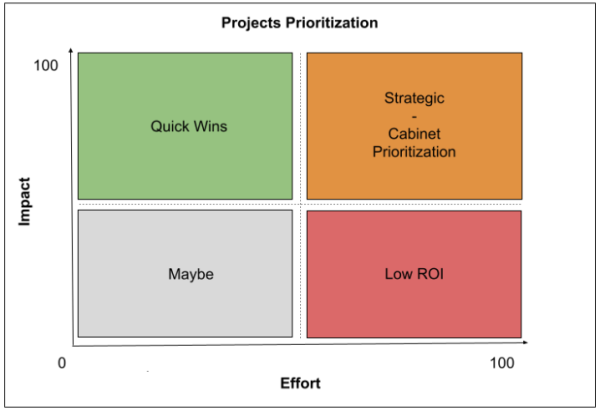Student Life Technology Solutions (SLTS), formed in 2018, provides technology services and consulting for over 25 different departments in Student Life, ranging from the Office of Multi-Ethnic Student Affairs to Michigan Dining.
During an initial survey of departmental leadership from each unit, SLTS identified a number of strategic priorities that would guide our formative first few years. One of those priorities was creating a transparent project prioritization and management methodology that considers the varied needs of all Student Life departments, whether large or small.
Our project prioritization process examines factors such as the risk of not doing a project, student impact, business impact, and alignment with Student Life’s strategic priorities and core work. We refer to this dimension as “impact” and plot it against “effort,” for which we estimate the number of Full Time Equivalent hours required for any given project.

Once visualized, proposed projects can be compared, and a determination can be made regarding whether or not to undertake any given project.
Projects with low impact and low effort (Maybe) and those that have a low impact and high effort (Low Return on Investment, or ROI) are the least likely to be undertaken. An example could be providing a single Student Life unit with a specialized reservation system for the loan of equipment to a few affiliated student groups. The impact would be low because it affects only one Student Life unit and a small subset of students, and the effort would be high because it requires custom web development.
Like many IT organizations on campus, we look for Quick Wins: projects that take little effort yet have a high impact. These are the projects most likely to be undertaken.
Projects with both high impact and high effort, such as replacing a major business system, are typically given consideration by Student Life’s “cabinet,” composed of Student Life’s Vice President and Associate Vice Presidents. The cabinet controls the significant budget dollars associated with these projects, so they need to weigh in on relative priorities and approve funding.
Associate Vice President for Student Life Auxiliary Services, Kambiz Khalili, shares: “The project prioritization process has allowed me to identify which projects are value-added for the entire division and have the most positive impact on the students’ experience. This process allows SLTS to better utilize their resources and maximize their support for all units within SL.”
All levels of leadership in Student Life appreciate the deliberate structure and decision-making created by the process SLTS uses.
“In a Student Life division that has significantly more needs than resources, this process has produced more strategic thinking for the Recreational Sports team and likely the entire division,” shares Mike Widen, director of Recreational Sports. “I think it has helped our staff better differentiate the ‘nice-to-have’ projects from the ‘critically needed’ projects.”
The project onboarding and prioritization process SLTS has put in place has brought increasing value to Student Life over the past several years. This article is the first in a series of articles from SLTS that will highlight our project onboarding process, the projects we complete, and their impact on the campus community. We hope you’ll enjoy learning more!
